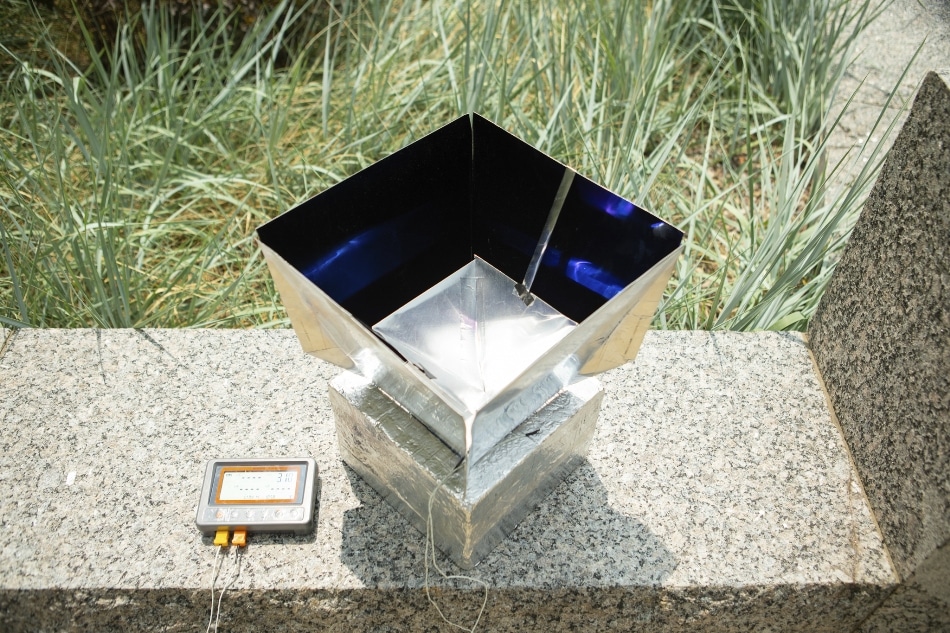Aug 6 2019
An innovative system designed by engineers can help cool buildings in packed metropolitan areas without using any electricity—a major breakthrough at a time when cities are trying to adjust to climate change.
 The system helps cool its surroundings by absorbing heat from the air inside the box and transmitting that energy through the Earth’s atmosphere into outer space. (Credit: University at Buffalo.
The system helps cool its surroundings by absorbing heat from the air inside the box and transmitting that energy through the Earth’s atmosphere into outer space. (Credit: University at Buffalo.
The new system includes an unusual material—a low-cost polymer/aluminum film —that is fitted within a box at the base of an exclusively developed solar “shelter.” This polymer/aluminum film absorbs heat from the air present inside the box and transmits that energy via the Earth’s atmosphere into the outer space. This process helps in keeping the surroundings cool.
The solar “shelter” serves a dual purpose—it blocks the incoming sunlight and simultaneously beams the thermal radiation produced from the film toward the sky.
The polymer stays cool as it dissipates heat through thermal radiation, and can then cool down the environment. This is called radiative or passive cooling, and it’s very interesting because it does not consume electricity—it won’t need a battery or other electricity source to realize cooling.
Lyu Zhou, Study Co-First Author and PhD Candidate, Electrical Engineering, School of Engineering and Applied Sciences, University at Buffalo
“One of the innovations of our system is the ability to purposefully direct thermal emissions toward the sky,” stated lead researcher Qiaoqiang Gan, PhD and associate professor of electrical engineering at the University at Buffalo (UB). “Normally, thermal emissions travel in all directions. We have found a way to beam the emissions in a narrow direction.
Gan continued, “this enables the system to be more effective in urban environments, where there are tall buildings on all sides. We use low-cost, commercially available materials, and find that they perform very well.”
Collectively, the shelter-and-box system designed by the engineers measures approximately 10” wide, 18” tall (45.72 cm), and 10” long (25.4 cm). To cool a single building, many units of the system would need to be fitted to cover a roof.
The results of the study have been published in Nature Sustainability on August 5th, 2019. The research was an international association between Gan’s team at UB, Zongfu Yu’s team at the University of Wisconsin–Madison; and Boon Ooi’s team at King Abdullah University of Science and Technology (KAUST) in Saudi Arabia.
In addition to Zhou, Haomin Song, PhD, UB assistant professor of research in electrical engineering, and Jianwei Liang at KAUST are co-first authors of the study. The National Science Foundation partly funded the study.
A System that Works During the Day and in Crowded Environments
The innovative passive cooling system tackles a major issue in the field—how radiative cooling can operate in packed urban areas and during the daytime?
During the night, radiative cooling is easy because we don’t have solar input, so thermal emissions just go out and we realize radiative cooling easily. But daytime cooling is a challenge because the sun is shining. In this situation, you need to find strategies to prevent rooftops from heating up. You also need to find emissive materials that don’t absorb solar energy. Our system address these challenges.
Haomin Song, PhD, Assistant Professor of Research, Electrical Engineering, University at Buffalo
When the heat-emanating film and solar shelter is placed outside during the daytime, it helped in decreasing the temperature of a compact, enclosed space by as much as 6 °C (11 °F). During the night, that figure increased to approximately 11 °C (around 20 °F).
How Innovative Architecture can Drive Radiative Cooling
The latest radiative cooling system integrates several design features that are optically fascinating. The polymer/metal film is one of the core components and is fabricated from an aluminum sheet coated with a clear polymer known as polydimethylsiloxane. While sunlight is reflected by the aluminum, heat from the surrounding air are absorbed and dissipated by the polymer.
The material was placed at the base of a foam box and a solar “shelter” was built atop the box. This was done by utilizing a solar energy-absorbing material to build four outward-slanting walls, together with an inverted square cone inside those walls.
This design serves a dual purpose—first, it helps in absorbing sunlight, and second, the shape of the cone and walls direct the heat produced by the film into the sky.
“If you look at the headlight of your car, it has a certain structure that allows it to direct the light in a certain direction,” Gan stated. “We follow this kind of a design. The structure of our beam-shaping system increases our access to the sky. The ability to direct the emissions improves the performance of the system in crowded areas.”